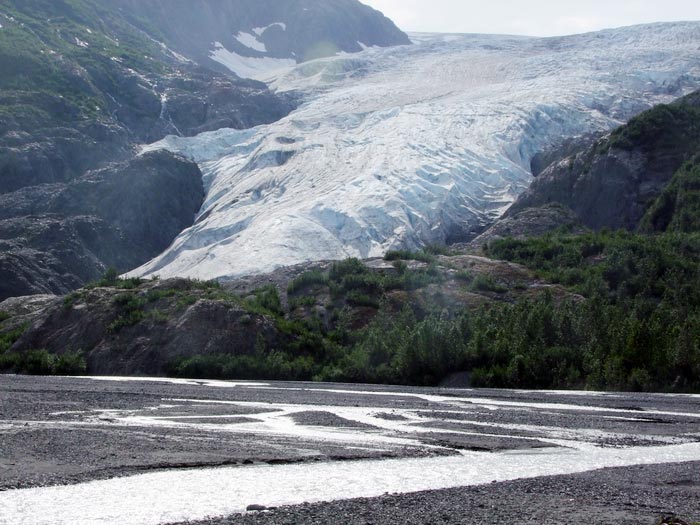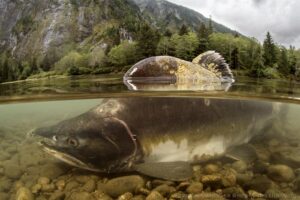Melting glaciers may produce thousands of kilometers of new Pacific salmon habitat

Exit Glacier, in Alaska, is one of hundreds of glaciers that are melting and retreating creating new salmon habitat.
Photo credit: Alexander Milner
Retreating glaciers in the Pacific mountains of western North America could produce around 6,150 kilometers of new Pacific salmon habitat by the year 2100, according to a new study.
Scientists have ‘peeled back the ice’ from 46,000 glaciers between southern British Columbia and south-central Alaska to look at how much potential salmon habitat would be created when underlying bedrock is exposed and new streams flow over the landscape.

Modeling glacier retreat under different climate change scenarios, researchers discovered that, under a moderate temperature increase, the glaciers could reveal potential new Pacific salmon habitat nearly equal to the length of the Mississippi River (6,275 km).
Desirable for salmon, in this case, means low-gradient streams (less than 10% incline) connected to the ocean with retreating glaciers at their headwaters. The team discovered that 315 of the glaciers examined met this criteria.
The international team, led by researchers at Simon Fraser University (Canada) with University of Birmingham (UK) and other organisations, published their findings today in Nature Communications.
Lead author, Simon Fraser University spatial analyst Dr. Kara Pitman comments: “We predict that most of the emerging salmon habitat will occur in Alaska and the transboundary region, at the British Columbia‒Alaska border, where large coastal glaciers still exist. The Gulf of Alaska sub-region is predicted to see the most gains—a 27% increase in salmon-accessible habitat by 2100.
“Once conditions stabilise in the newly-formed streams, salmon can colonise these areas quite quickly. It’s a common misconception that all salmon return home to the streams they were born in. Most do, but some individuals will stray—migrating into new streams to spawn and, if conditions are favorable, the population can increase rapidly.”
Co-author Professor Alexander Milner from the University of Birmingham has researched glacial retreat and salmon populations in southeast Alaska for over three decades. His team have worked on Stonefly Creek in Glacier Bay where glacier retreat reveal a new stream in the late 1970s and he comments
“Colonization by salmon can occur relatively quickly after glacial retreat creates favourable spawning habitat in the new stream. For example, Stonefly Creek was colonised within 10 years by pink salmon that grew rapidly to more than 5,000 spawners. Other species also colonised including Coho and Sockeye salmon, especially where a lake is associated with the stream”
The researchers caution that while the newly created habitat is a positive for salmon in some locations; overall, climate change still poses grave challenges for some salmon populations.
“On one hand, this amount of new salmon habitat will provide local opportunities for some salmon populations,” says Dr. Pitman. “On the other hand, climate change and other human impacts continue to threaten salmon survival—via warming rivers, changes in stream flows, and poor ocean conditions.
“Climate change means we increasingly need to look to the future. We can’t just protect current-day habitat for species but need to consider what habitats they might rely on in the future.”
For further information, interviews or an embargoed copy of the research paper, please contact Tony Moran, International Communications Manager, University of Birmingham on +44 (0)782 783 2312 or t.moran@bham.ac.uk. Out-of-hours, please call +44 (0) 7789 921 165.
Photo captions:
- Exit Glacier, in Alaska, is one of hundreds of glaciers that are melting and retreating creating new salmon habitat. Photo credit: Alexander Milner.
- Salmon can colonize newly created streams, but face many other challenges from climate change. Photo credit: Freshwaters Illustrated.
Notes for editors
- The University of Birmingham is ranked amongst the world’s top 100 institutions. Its work brings people from across the world to Birmingham, including researchers, teachers and more than 6,500 international students from over 150 countries.
- ‘Glacier retreat creating new Pacific salmon habitat in western North America’ – Pitman, Kara J; Moore, Jonathan W.; Sloat, Matthew R.; Huss, Matthias; Whited, Diane C.; Beechie, Tim J.; Brenner, Rich; Hood, Eran W.; Milner, Alexander M.; Pess, George R.; Reeves, Gordan H.; and Schindler, Daniel E. is published by Nature Communications. Please use this post-embargo link to the research paper in any online stories: https://www.nature.com/articles/s41467-021-26897-2
- Researchers participated in the study from:
- University of Birmingham, UK
- Simon Fraser University, Burnaby, British Columbia, Canada
- Alaska Department of Fish and Game, Juneau, USA
- ETH Zurich, Switzerland
- Northwest Fisheries Science Center, NOAA Fisheries, Seattle, Washington, USA
- Swiss Federal Institute for Forest, Snow and Landscape Research (WSL), Birmensdorf, Switzerland
- University of Alaska Southeast, Juneau, USA
- University of Fribourg, Switzerland
- University of Montana, Polson, USA
- University of Washington, Seattle, USA
- USDA Forest Service, Pacific Northwest Research Station, Corvallis, USA
- Wild Salmon Center, Portland, USA
Journal: Nature Communications
Method of Research: Data/statistical analysis
Subject of Research: Animals
Article Title: Glacier retreat creating new Pacific salmon habitat in western North America
Article Publication Date: 7-Dec-2021
Media Contact
Tony Moran
University of Birmingham
t.moran@bham.ac.uk
Cell: 7827832312
All latest news from the category: Ecology, The Environment and Conservation
This complex theme deals primarily with interactions between organisms and the environmental factors that impact them, but to a greater extent between individual inanimate environmental factors.
innovations-report offers informative reports and articles on topics such as climate protection, landscape conservation, ecological systems, wildlife and nature parks and ecosystem efficiency and balance.
Newest articles

Silicon Carbide Innovation Alliance to drive industrial-scale semiconductor work
Known for its ability to withstand extreme environments and high voltages, silicon carbide (SiC) is a semiconducting material made up of silicon and carbon atoms arranged into crystals that is…

New SPECT/CT technique shows impressive biomarker identification
…offers increased access for prostate cancer patients. A novel SPECT/CT acquisition method can accurately detect radiopharmaceutical biodistribution in a convenient manner for prostate cancer patients, opening the door for more…

How 3D printers can give robots a soft touch
Soft skin coverings and touch sensors have emerged as a promising feature for robots that are both safer and more intuitive for human interaction, but they are expensive and difficult…





















